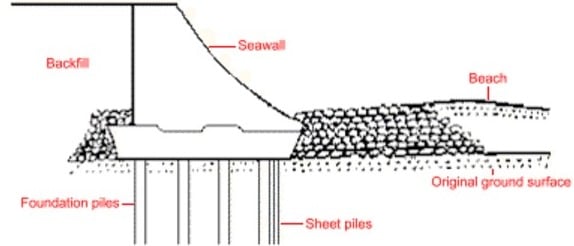Excitement About Shore Protect Team
Table of ContentsThe Facts About Shore Protect Team RevealedSee This Report about Shore Protect TeamShore Protect Team Fundamentals ExplainedThe Only Guide for Shore Protect TeamExcitement About Shore Protect TeamThe Best Strategy To Use For Shore Protect TeamThe 6-Minute Rule for Shore Protect Team
Reduction in residential property value: As the area tourism is influenced by disintegration, so then is the economy. Purchasers are much less most likely to look for a beach residence that could be destroyed anytime by the approaching flooding and erosion emergency situation. Consequently, building worth can drop tremendously and influence the whole region.Whether a beach is simply tiny and crowded or has to close totally for the safety and security of the environment and nearby residential properties, this greatly affects tourist. Subsequently, neighborhood economic situations are affected (https://moz.com/community/q/user/shrprtcttm). Risk of injury: The raised risk of flooding and architectural failures triggers a boosted danger of injury to nearby visitors and neighborhood participants

Coastline stablizing is straight relevant to their work. Waterside resorts: Since coastline erosion influences tourist, it influences the success of waterside hotels.
The Basic Principles Of Shore Protect Team
This ultimately brings about closures and abandoned beachfront properties. Coastal commercial services: No visitors means no business. For those businesses dealing with citizens, their residential or commercial property is at threat of damage from erosion and flooding. Coastal state parks: State parks that exist along coastlines go to danger of damages. Not just to the manmade frameworks and residential or commercial properties on website, yet also to the all-natural ecological communities that exist within.
Difficult stabilization utilizes man-made structures as defense to manage disintegration. Many types of hard stablizing like seawalls and sheet metal are not perfect for shoreline stabilization.
Shore Protect Team - Truths
There's likewise not nearly enough evidence of their efficiency depending on the kind of shoreline and neighborhood problems. Difficult stabilization strategies tend to be a lot more tough to set up and do not match the natural aesthetic, standing out like a sore thumb and hurting regional ecosystems in several situations. Coastline nutrients is the process of adding shed sand and sediment back to coastlines after erosion has actually occurred.
TrapBags help in the procedure of beach nutrition by safeguarding all-natural environments and enabling plants to grow. They're: Environmentally friendly: You can make use of native dirt both to surround and to fill up the TrapBags.

About Shore Protect Team
They can additionally be set up without any heavy machinery. Budget friendly: TrapBags are excellent for both little and huge locations of shoreline.
Integrated with a high construction expense, this has caused enhancing usage of various other soft engineering seaside monitoring alternatives such as coastline replenishment. Seawalls are created from various products, many commonly reinforced concrete, rocks, steel, or gabions. Other possible construction materials include plastic, timber, aluminum, fiberglass composite, and naturally degradable sandbags made of hemp and coir. The ideal seawall layout depends on location-specific elements, consisting of bordering erosion processes. There are 3 primary kinds of seawalls: vertical, rounded, stepped, and piles (see table listed below). A record published by the United Nations Setting Program (UNEP) recommends that the tsunami of 26 December 2004 created less damages in the locations where natural barriers existed, such as mangroves, reef or coastal plants.
All-natural obstacles, such as reef and mangrove woodlands, prevent the spread of tidal waves and the circulation of seaside waters and alleviated the flooding and rise of water. A cost-benefit approach is a reliable way to figure out whether a seawall is suitable and whether the benefits are worth the expenditure.
Getting The Shore Protect Team To Work
A seawall is a static feature which can conflict with the dynamic nature of the coastline and hamper the exchange of sediment in between land and sea. The table below sums up some favorable and negative effects of seawalls which can be made use of when comparing their performance with other seaside monitoring choices, such as coastline nourishment. [] Benefits and negative aspects of seawalls according to Short (1999) Advantages Negative aspects Lengthy term service in comparison to soft coastline nutrition.

This can trigger coastlines to dissipate, providing them worthless for beach goers. Typically, seawalls can be an effective method to control coastal erosion, however just if they are created well and out of products that can hold up against the pressure of continuous wave power. Some understanding is required of the coastal processes and morphodynamics particular to the seawall area.
The Shore Protect Team Statements
The proper seawall style relies upon location-specific elements, including bordering disintegration processes. There are three main kinds of seawalls: vertical, rounded, tipped, and mounds (see table below). A record released by the United Nations Atmosphere Programme (UNEP) recommends that the tsunami of 26 December 2004 caused much less damage in the locations where all-natural barriers existed, such as mangroves, coral reefs or coastal vegetation.
Natural obstacles, such as reef and mangrove forests, protect against the spread of tidal waves and the flow of seaside waters and reduced the flooding and rise of water. A cost-benefit technique is a reliable way to identify whether a seawall is ideal and whether the advantages are worth the expenditure.
Excitement About Shore Protect Team
A seawall is a static attribute which can clash with the vibrant nature of the coast and impede the exchange of sediment between land and sea. Benefits and drawbacks of seawalls according to Short (1999) Advantages Disadvantages Lengthy term solution in comparison to soft coastline nutrients.

This can trigger beaches to dissipate, rendering them pointless for coastline goers. Usually, seawalls can be a successful method to regulate seaside disintegration, yet only if they are built well and out of products that can withstand the force of ongoing wave energy. Some understanding is needed of the coastal procedures and morphodynamics specific to the seawall location.